James C. VanderKam




xii
xiv
 ore than fifteen years have passed since The Dead Sea Scrolls Today first appeared, rendering its title increasingly more inappropriate. The early 1990s were exciting and confusing times in research on the Scrolls: publication of fragmentary texts had resumed in earnest after too long a hiatus, articles and books appeared all the time, and conspiracy theories were rife but beginning to be debunked. Now, in 2010, more than sixty years after the first scrolls came to light and when all them have been published, it is possible to view from a larger perspective what has happened and to sketch the current stage in Scrolls research.
ore than fifteen years have passed since The Dead Sea Scrolls Today first appeared, rendering its title increasingly more inappropriate. The early 1990s were exciting and confusing times in research on the Scrolls: publication of fragmentary texts had resumed in earnest after too long a hiatus, articles and books appeared all the time, and conspiracy theories were rife but beginning to be debunked. Now, in 2010, more than sixty years after the first scrolls came to light and when all them have been published, it is possible to view from a larger perspective what has happened and to sketch the current stage in Scrolls research.
The second edition of The Dead Sea Scrolls Today retains the format, style, and aims of the first edition, and the same wider audience is envisaged. There seemed no reason to make changes in those respects because the reception the first edition received shows that the book served a useful purpose. It sold far more copies than anticipated and was translated into six languages (Danish, German, Italian, Japanese, Polish, Portuguese). The major kinds of changes in the second edition are these:
First, the information is updated to take into account the full publication of the texts from the caves and the post-1994 debates about the Qumran site, including the later dating of the sectarian occupation of it and the implications following from the revised chronology.
Second, the bibliographies at the end of the chapters have been enlarged.
Third, there is an additional section regarding information the Scrolls provide about Second Temple Judaism and the groups prominent at the time.
Fourth, the phrasing has been changed in many places.
Finally, quotations of the Scrolls are from the fifth edition of Geza Vermes's translation, The Complete Dead Sea Scrolls in English (New York/London: Penguin, 1997). The page numbers in that volume follow the citations from it.
It is a pleasant duty to thank those who have helped in the process of preparing the second edition. First, I am grateful to those many good people who, at lectures, Scrolls exhibits, and other venues have offered kind words and helpful suggestions about the book. Second and more specifically, several individuals have read the text and made detailed suggestions for improvements: my wife, Mary VanderKam, who has an aversion to passive verbs and flagged others of my stylistic peculiarities; Molly Zahn, Ardea Russo, and Kevin Haley (all former or present doctoral students at Notre Dame), who compiled lists of changes and suggestions, and Monica Brady, who prepared the manuscript, advised about many matters, including the illustrations and photographs, and read the proofs. A word of thanks is also due to Catherine (Kitty) Murphy for permission to use some of the wonderful photos she has shot of Qumran and its vicinity.
Several friends have also been kind enough to answer questions: Brian Schultz on the War Rule, Eileen Schuller on the Hymn Scroll from Cave 1, Eugene Ulrich regarding the biblical manuscripts, Sue Sheridan on the cemetery, and Marty Abegg and Emanuel Tov regarding some electronic publications. And finally, I am once again grateful to the skillful people at Eerdmans for producing such an attractive book.

 much better writer once said: "I too decided, after investigating everything carefully from the very first, to write an orderly account for you, most excellent Theophilus, so that you may know the truth concerning the things about which you have been instructed" (Luke 1:3-4). Many have recently written about the Dead Sea Scrolls and aspects of the controversies that have engulfed them. The result has been confusion about what has actually happened. The media tend to publicize the sensational and to give more space to idiosyncratic theories than to the ones more widely held. If anyone claims to have discovered a new messianic reference in a scroll fragment and maintains that it somehow has extraordinary consequences for Christianity, the newspapers will spread the word abroad. But when more considered opinions are reached, they gain little attention. In the light of this situation, it seemed worthwhile to write an orderly account about the Scrolls themselves and what has happened with them since the mid-198os.
much better writer once said: "I too decided, after investigating everything carefully from the very first, to write an orderly account for you, most excellent Theophilus, so that you may know the truth concerning the things about which you have been instructed" (Luke 1:3-4). Many have recently written about the Dead Sea Scrolls and aspects of the controversies that have engulfed them. The result has been confusion about what has actually happened. The media tend to publicize the sensational and to give more space to idiosyncratic theories than to the ones more widely held. If anyone claims to have discovered a new messianic reference in a scroll fragment and maintains that it somehow has extraordinary consequences for Christianity, the newspapers will spread the word abroad. But when more considered opinions are reached, they gain little attention. In the light of this situation, it seemed worthwhile to write an orderly account about the Scrolls themselves and what has happened with them since the mid-198os.
In January 199o J. T. Milik, one of the first and best editors of the Scrolls, gave to me the right to publish twelve manuscripts that had been assigned to him. After receiving his photographs and notes, I studied the originals in the Rockefeller Museum in Jerusalem, examined the materials Milik had given to me, and with Milik have been publishing those texts. In March 199o I got a rapid introduction to how controversial the Scrolls had become. When asked by a newspaper reporter whether I would be willing to show the photographs to others, I said yes. That one short answer soon had others on the telephone, and my comment was published and reported in several places. Willingness to show others the photographs was a departure from official policy, so it seems. It was even termed a major breakthrough! I still cannot understand why anyone should deny others the right to examine the pictures of scroll fragments, but the experience illustrated the tensions and strong feelings then surrounding the whole issue of access to the Scrolls. As I have learned more about what had happened in the nearly forty years of scholarship on the Cave 4 manuscripts, I began to understand more about the genesis of people's feelings on both sides of the issue.
The present introduction and update on the Scrolls is intended for a wide audience. I have attempted to cover the major areas of Scrolls research and to bring the latest information to bear on them. Only recently have complete lists of the Qumran texts become available. Now for the first time it is possible to look at the entire extraordinary library that had been hidden away in the eleven caves. The book was written at the suggestion of Jon Pott of Wm. B. Eerdmans Publishing Company. I am grateful to him for the suggestion and for his supervision of the process that has so quickly put the manuscript in print.

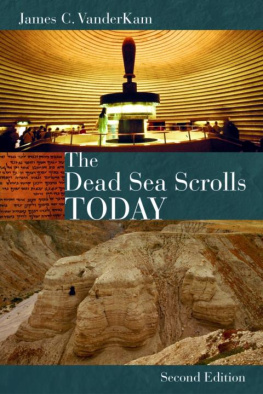
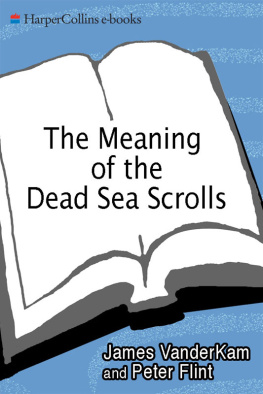



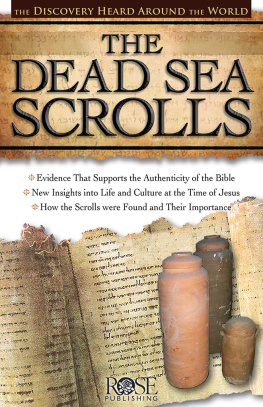

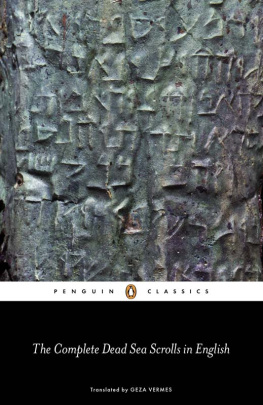
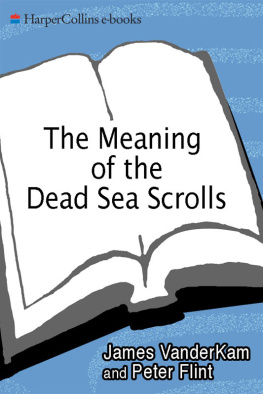

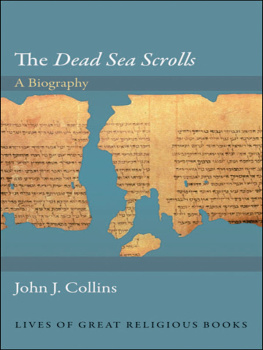





 ore than fifteen years have passed since The Dead Sea Scrolls Today first appeared, rendering its title increasingly more inappropriate. The early 1990s were exciting and confusing times in research on the Scrolls: publication of fragmentary texts had resumed in earnest after too long a hiatus, articles and books appeared all the time, and conspiracy theories were rife but beginning to be debunked. Now, in 2010, more than sixty years after the first scrolls came to light and when all them have been published, it is possible to view from a larger perspective what has happened and to sketch the current stage in Scrolls research.
ore than fifteen years have passed since The Dead Sea Scrolls Today first appeared, rendering its title increasingly more inappropriate. The early 1990s were exciting and confusing times in research on the Scrolls: publication of fragmentary texts had resumed in earnest after too long a hiatus, articles and books appeared all the time, and conspiracy theories were rife but beginning to be debunked. Now, in 2010, more than sixty years after the first scrolls came to light and when all them have been published, it is possible to view from a larger perspective what has happened and to sketch the current stage in Scrolls research. much better writer once said: "I too decided, after investigating everything carefully from the very first, to write an orderly account for you, most excellent Theophilus, so that you may know the truth concerning the things about which you have been instructed" (Luke 1:3-4). Many have recently written about the Dead Sea Scrolls and aspects of the controversies that have engulfed them. The result has been confusion about what has actually happened. The media tend to publicize the sensational and to give more space to idiosyncratic theories than to the ones more widely held. If anyone claims to have discovered a new messianic reference in a scroll fragment and maintains that it somehow has extraordinary consequences for Christianity, the newspapers will spread the word abroad. But when more considered opinions are reached, they gain little attention. In the light of this situation, it seemed worthwhile to write an orderly account about the Scrolls themselves and what has happened with them since the mid-198os.
much better writer once said: "I too decided, after investigating everything carefully from the very first, to write an orderly account for you, most excellent Theophilus, so that you may know the truth concerning the things about which you have been instructed" (Luke 1:3-4). Many have recently written about the Dead Sea Scrolls and aspects of the controversies that have engulfed them. The result has been confusion about what has actually happened. The media tend to publicize the sensational and to give more space to idiosyncratic theories than to the ones more widely held. If anyone claims to have discovered a new messianic reference in a scroll fragment and maintains that it somehow has extraordinary consequences for Christianity, the newspapers will spread the word abroad. But when more considered opinions are reached, they gain little attention. In the light of this situation, it seemed worthwhile to write an orderly account about the Scrolls themselves and what has happened with them since the mid-198os.